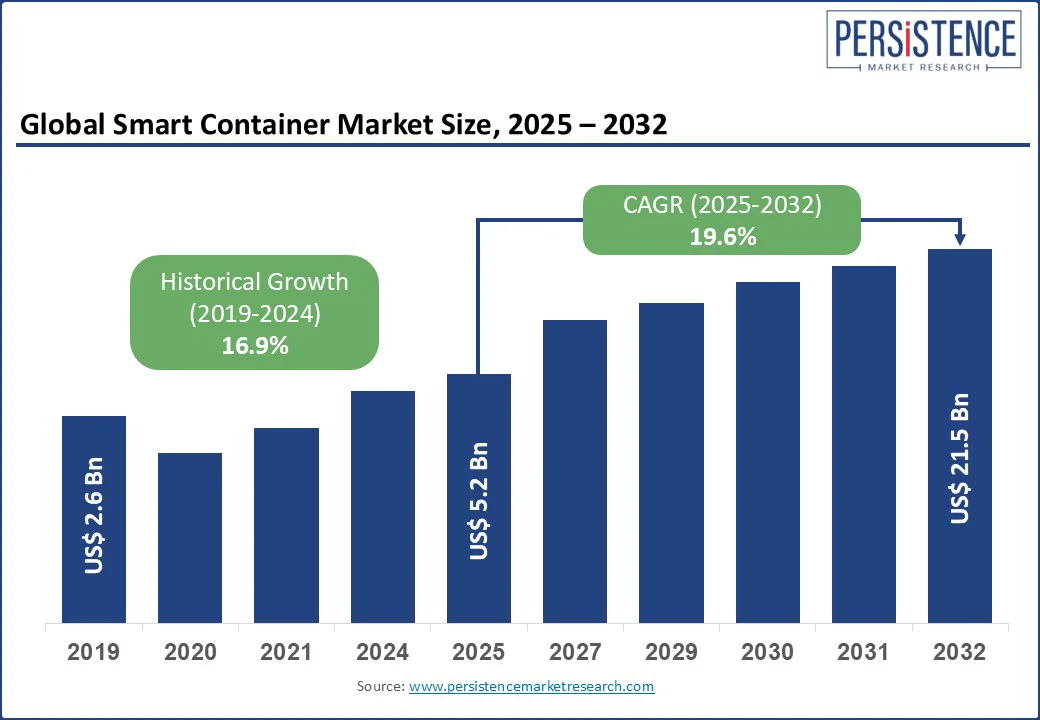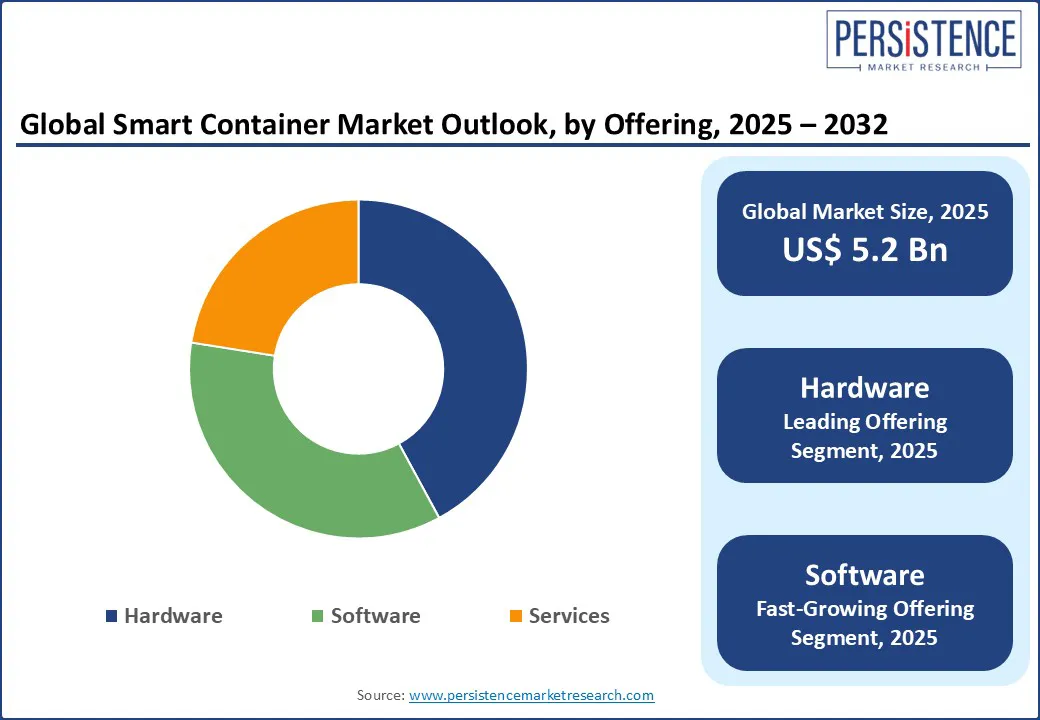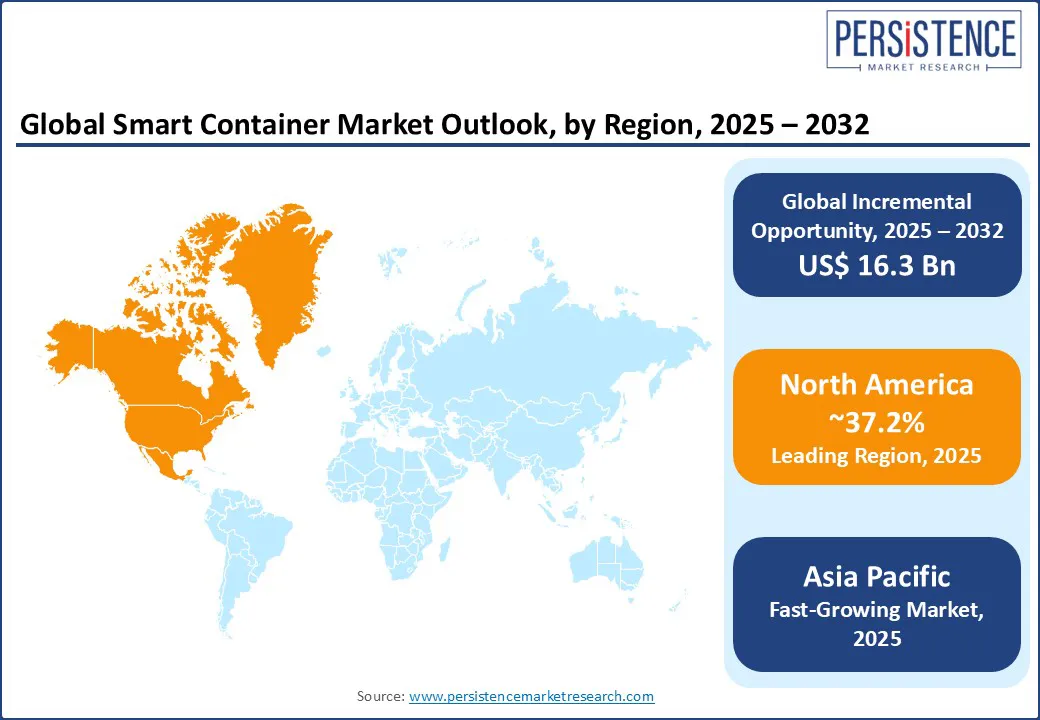ID: PMRREP35533| 195 Pages | 30 Jul 2025 | Format: PDF, Excel, PPT* | Packaging

The global smart container market size is likely to be valued at US$ 5.2 Bn in 2025 and is estimated to reach US$ 21.5 Bn in 2032, growing at a CAGR of 19.6% during the forecast period 2025 - 2032. Global logistics is undergoing a structural shift. Smart containers are emerging as important assets for companies striving to achieve real-time visibility, operational resilience, and cost optimization across increasingly complex supply chains. These next-generation shipping containers, embedded with IoT sensors, telematics modules, and data analytics capabilities, are transforming the way cargo is monitored, secured, and managed during multimodal transit. As disruptions challenge conventional freight systems, smart containers allow businesses to move from reactive troubleshooting to proactive decision-making.

Key Industry Highlights:
|
Global Market Attribute |
Key Insights |
|
Smart Container Market Size (2025E) |
US$ 5.2 Bn |
|
Market Value Forecast (2032F) |
US$ 21.5 Bn |
|
Projected Growth (CAGR 2025 to 2032) |
19.6% |
|
Historical Market Growth (CAGR 2019 to 2024) |
16.9% |
Increasing emphasis on end-to-end (E2E) supply chain visibility is boosting the smart container market growth, especially in sectors where real-time data on cargo condition and location is important. Following widespread supply chain disruptions during the COVID-19 pandemic and the Suez Canal blockage in 2021, companies began prioritizing transparency across the entire logistics chain to mitigate risks. Smart containers address this demand by offering integrated sensors and connectivity solutions that transmit real-time data on location, temperature, humidity, shock, and door status.
Pharmaceutical and perishable goods shippers are turning to these technologies to ensure compliance with safety regulations and reduce spoilage. In addition, frameworks such as the EU's proposed Digital Product Passport and the U.S. Food Safety Modernization Act (FSMA) Rule 204 are propelling demand for traceability. These are further compelling logistics providers to adopt smart container solutions. Demand is also being accelerated by ESG-conscious brands seeking Scope 3 emissions reporting through container-level telemetry.
Cybersecurity vulnerabilities are a barrier to the widespread adoption of smart containers. These containers collect and transmit sensitive data, including cargo contents, GPS location, and routing details, over cellular and satellite networks. This creates multiple points of entry for cyberattacks. In 2023, the shipping giant DNV experienced a ransomware attack that disrupted over 1,000 vessels using its ship management software. While this incident did not directly involve smart containers, it raised awareness across maritime logistics about the risks of digitization.
The reliance on consistent and high-quality network infrastructure also remains a significant limitation. It is evident across trade routes in developing regions where 5G or even stable 4G coverage is lacking. Routes through Sub-Saharan Africa and parts of Southeast Asia, for instance, often experience communication blackouts, making real-time monitoring patchy and less reliable. This restricts the value proposition of smart containers for companies operating in or through these regions.
The convergence of innovative sensor technology with 5G connectivity is creating transformative opportunities in the market. Traditional telematics solutions relied heavily on 2G/3G networks with limited bandwidth and latency issues, constraining the scope of real-time monitoring. With the rollout of 5G, smart containers can now support high-frequency data transmission, including video feeds, real-time tamper alerts, and dynamic environmental controls. Simultaneously, the miniaturization and enhanced accuracy of modern sensors are extending the range of parameters that can be tracked in containers.
New-generation smart containers can now measure not just temperature and humidity, but also carbon dioxide levels, light exposure, and container tilt in real time. This is proving valuable for the transportation of high-value goods such as fine art, medical isotopes, and luxury electronics. Additionally, predictive analytics powered by these rich data streams are being used to preempt spoilage, theft, and maintenance issues. AI models trained in sensor data now help suggest optimal rerouting in response to weather changes or port delays.
Based on offering, the market is trifurcated into hardware, software, and services. Out of these, hardware is speculated to hold nearly 42.1% of the smart container market share in 2025 due to the increasing demand for real-time, sensor-based insights that cannot be achieved through software alone. As global supply chains prioritize transparency, physical components such as GPS modules and door-open detectors are becoming essential for capturing in-transit data directly at the container level. The shift is also boosted by developments in sensor miniaturization and durability.
Software offerings are gaining momentum owing to the surging demand for novel data analytics, predictive modeling, and cross-platform integration. While hardware captures raw sensor data, software platforms are now central to translating that information into actionable insights. These help in optimizing routes, minimizing spoilage, and enabling regulatory compliance. The increasing complexity of multi-modal supply chains is another significant factor spurring the segment.
By technology, the market is segregated into Global Positioning System (GPS), cellular, LoRaWAN (Long Range Wide Area Network), and Bluetooth Low Energy (BLE). Among these, GPS will likely account for around 37.3% of the share in 2025 owing to its ability to offer real-time, continuous, and highly accurate location data across international and intermodal supply chains. The integration of GPS with analytics platforms and geofencing capabilities allows companies to set automated alerts for customs zones, high-risk corridors, or unauthorized detours. Pharmaceutical and electronics exporters are increasingly using this feature to meet regulatory compliance and mitigate cargo tampering or theft risks in transit.
LoRaWAN is gaining impetus backed by its ability to transmit small packets of data over long distances with minimal power consumption. These features make it suitable for extended international shipping routes where continuous connectivity is a challenge. LoRaWAN allows sensors in smart containers to function autonomously for years, which is an essential feature for asset tracking in remote locations or during multi-week maritime transit. Another factor spurring adoption is the cost efficiency of LoRaWAN modules.

North America is expected to account for approximately 37.2% of share in 2025 owing to increasing demand from pharmaceuticals, food and beverage, e-commerce, and manufacturing sectors. These require tight climate control, real-time monitoring, and regulatory compliance. The U.S. smart container market is predicted to lead through 2032 with evolving cold-chain requirements and Food and Drug Administration (FDA) traceability mandates. Investments in port modernization, digital sensor deployments, and AI-based logistics optimization are also poised to create new growth avenues.
Canada is contributing to regional growth, albeit on a smaller scale. The country is currently witnessing a surge in deployment due to policy-backed digitization of cross-border trade. Canada's port authorities have adopted machine learning technologies to reduce inspection time by up to 70%, further incentivizing smart freight solutions. Public sector support and private innovation are also reinforcing each other in North America. In 2023, for instance, the U.S. Maritime Administration allocated over US$ 650 Mn for port digitization, including funding for smart container infrastructure and smart gates.
Asia Pacific is propelled by large-scale trade volume, government-led infrastructure upgrades, and a high demand for cold-chain logistics. China is at the forefront of growth due to its investments in Belt and Road logistics corridors as well as digital port infrastructure. The core driver of adoption in Asia Pacific is the food and beverage industry, which makes up more than one-third of the region’s smart container usage.
It is evident in Thailand, Vietnam, and the Philippines, where seafood and fruit exports require end-to-end cold-chain traceability. Japan and South Korea are seeing increasing deployment in pharmaceutical logistics. Smart intermodal containers with temperature sensors are seeing steady demand to comply with stringent health regulations. Several containers deployed in Singapore and South Korea also feature AI-backed alert systems and solar-powered energy harvesting.
Europe represents one of the most regulation intensive markets worldwide. Adoption is anchored in sectors with tight compliance and cold chain demands. Germany, the U.K., France, Belgium, and the Netherlands lead in terms of deployments. EU regulations on sustainability, traceability, and emissions are significant enablers. Exporters are required to maintain auditable logs for allergens, carbon footprints, and shelf life. Pilot projects pairing encrypted sensor feeds with blockchain-based carbon reporting modules are increasingly common, especially for supporting Scope 3-related ESG compliance.
Domestic port ecosystems are further accelerating deployments. For example, the Port of Rotterdam tracks around 85% of containers via RFID and GPS sensors in its Port Community System. Similarly, Hamburg’s smart container adoption surged about 30% year-on-year in 2023, partly due to mandatory pharma traceability rules. Local public funding is further bolstering adoption. The EU’s Trans-European Transport Network (TEN-T) program allocated approximately €1.2 Bn (US$ 1.31 Bn) toward smart logistics infrastructure, benefiting Mediterranean hubs such as Valencia and Piraeus.

The global smart container market is characterized by various logistics technology providers, sensor manufacturers, and established shipping container companies integrating IoT container trackers into their offerings. Leading companies have carved out distinct niches by offering real-time tracking, geofencing, and cargo condition monitoring. A few others compete in the broad reefer container monitoring field, integrating satellite and cellular communications to track temperature, humidity, and door openings. Emerging competitors from Asia Pacific are introducing cost-efficient solutions with strong domestic logistics partnerships.
The smart container market is projected to reach US$ 5.2 Bn in 2025.
Increasing e-commerce-led cross-border trade and surging cargo theft incidents are the key market drivers.
The smart container market is poised to witness a CAGR of 19.6% from 2025 to 2032.
Growth in smart leasing models and blockchain integration for secure data exchange are the key market opportunities.
Globe Tracker, ORBCOMM, and Phillips Connect Technologies are a few key market players.
|
Report Attribute |
Details |
|
Historical Data/Actuals |
2019 - 2024 |
|
Forecast Period |
2025 - 2032 |
|
Market Analysis |
Value: US$ Bn |
|
Geographical Coverage |
|
|
Segmental Coverage |
|
|
Competitive Analysis |
|
|
Report Highlights |
|
|
Customization and Pricing |
Available upon request |
By Offering
By Technology
By Application
By End-user
By Region
Delivery Timelines
For more information on this report and its delivery timelines please get in touch with our sales team.
About Author